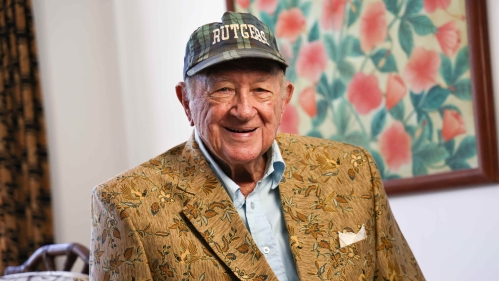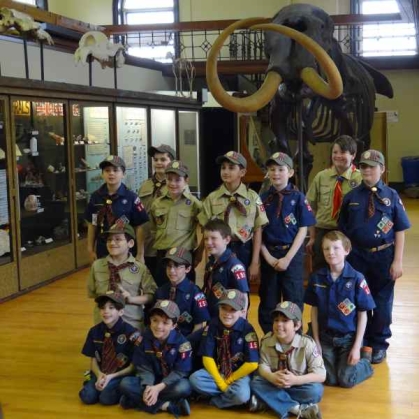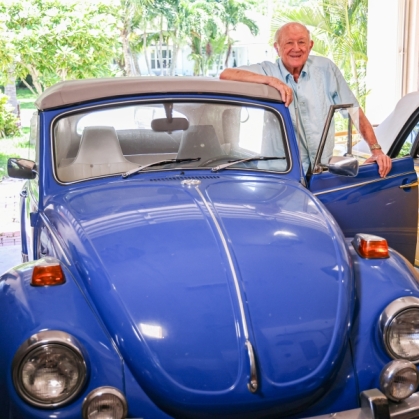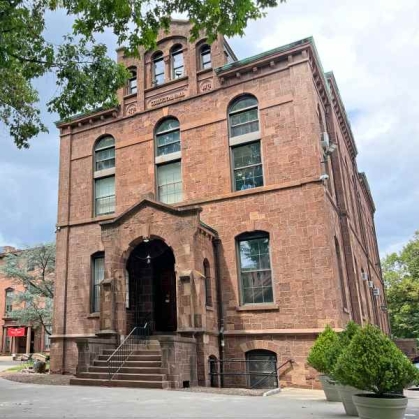Retired Geologist Gives Back to the Rutgers Museum that Inspired Him

World traveler Thomas Ambrose, who earned a graduate degree in 1951, supports the nation’s oldest geology museum at Rutgers.
A pack of Cub Scouts huddled outside Rutgers University’s historic Geology Hall, waiting for a free guided tour of the natural wonders inside the brownstone building on the College Avenue campus in New Brunswick.

Some of the kids climbed the stairs, discussing dinosaurs, and others craned their necks to read the placard beside the front door.
“A 10,000-year-old mastodon!” a boy says.
Thomas Ambrose, 98, a 1951 graduate of Rutgers College, remembers being similarly being awestruck by the Geology Museum’s mastodon skeleton as a student more than a 75 years ago.
“The museum is special,” says Ambrose. “I loved studying the fossils there.”
After graduating with a master’s degree in 1951, Ambrose took what he learned at Rutgers and embarked on an Indiana Jones-like career as a global exploration geologist in search of oil for the fossil fuel industry. He has visited 158 countries, sipping rum and Cokes in Havana before Fidel Castro took over Cuba, evading armed guerillas in Colombia, and watching volcanic ash blanket his home in Jakarta.

Ambrose says he once skidded off a dirt road in Yellowknife in Canada’s Northwest Territories. In Europe, he purchased a Volkswagen Beetle in Germany and drove it through Norway, Finland, Gibraltar, the former Yugoslavia, and Turkey before shipping it home to his home in Southeast Florida, where it remains today in his garage.
“I’m what you might call a citizen of the world,” says Ambrose, who has circumnavigated the planet twice and lives along the Southeast Florida coastline.
He recalls hours spent wandering the sunlit floors of the Rutgers museum and exploring the wider world around New Brunswick, like the now-shuttered Corner Tavern.
“All of my classes were in the basement then, and it felt a bit like a dungeon at times, so I loved going up there—I loved the museum,” Ambrose says. “I had a great experience at Rutgers. I could be in New York City in about 30 minutes and I’d go and hang out in the Village in Manhattan for fun. Two weeks after graduating I had a full-time job in the city in what was the world’s third-tallest building. They were happy to have a Rutgers graduate.”
Ambrose, a World War II and Korean War veteran drafted out of high school, last visited Rutgers about a decade ago for a reunion and made sure to get another peek at the museum’s mastodon. The nearly complete specimen was discovered in Salem County—New Jersey’s most southwestern county—in 1869 and mounted in the museum in 1896, becoming its centerpiece.
George H. Cook, for whom Cook Campus is named, founded the museum in 1872. A former state geologist, Cook led the New Jersey Geological Survey and needed a place to display and house its findings.
“Did you know it’s the oldest geology museum in the United States?” Ambrose says. “There’s the American Museum of Natural History in New York and there’s one in Chicago, but those are not pure geology.”

The museum, which celebrated its 150th birthday in 2022, is full of unique specimens from around the world, including whale vertebrae, a giant clam shell, a saber-toothed tiger skull, and a recently restored giant spider crab that sits atop a wooden, spiral staircase. There also are rows and rows of local rocks and minerals from New Jersey, including pink zoisite and glossy franklinite from Sussex County in Northwest New Jersey. In 1840, a former mine captain with the New Jersey Zinc Company donated 2,400 specimens of fluorescent minerals to the museum.
During their Cub Scouts tour, museum coordinator Ria Sarkar, a graduate student in geology, explains how fossils are made, and the various paths a geologist can go down, everything from climate to rocks and minerals, to earthquakes. But the kids have one thing on their mind.
“Wait, they study dinosaurs too, right?” a boy asks.
The Cub Scouts were given real shark teeth, crinoid fossils, and clam shells to make clay imprints with.
A jar by the museum’s entrance encouraged visitors to leave a donation, which helps with expenses and, above all else, keeps it free. Ambrose recently made a $2,000 donation to the museum, one of the largest single-donor contributions since its inception.
Lauren Neitzke Adamo, the museum’s director and a professor in the Department of Earth and Planetary Sciences at the School of Arts and Sciences, says donations such as Ambrose’s are invaluable to making geology accessible to underserved communities.
“Many schools and community groups can’t make those trips to the big museums in the city because of busing and waivers,” she says. “The cost can add up. We’re free and we hope to always keep it that way.”
While Rutgers was the launchpad for a globe-trotting life, Ambrose had geology on his mind as far back as he can remember.
“I was born almost in the middle of an Oklahoma City oil field,” Ambrose says. “The Oklahoma City field blew in as a gusher spilled thousands and thousands of barrels of oil all over the countryside. You could see the wells all over the place.”
Ambrose doesn’t think he’ll get back to the Geology Museum again but hopes it continues to inspire, to spark the passion that pushed him from country to country. Ambrose is long since retired, and while he keeps track of new oil discoveries around the globe, he spends most of his time devoted to different geology—the finely ground rocks and minerals near his home: sand.
“Basically,” he says, “I’m a beach bum.”
For more information about Rutgers Geology Museum, visit geologymuseum.rutgers.edu.

WE ARE YOU is an ongoing series of stories highlighting Rutgers University’s unwavering commitment to academic excellence, building community, and the common good.
Support the Geology Museum
Consider a gift to support the museum that has been at Rutgers for more than 150 years.
Give Now
